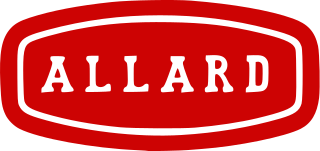
Allard Motor Company Limited was a London-based low-volume car manufacturer founded in 1945 by Sydney Allard in small premises in Clapham, south-west London. Car manufacture almost ceased within a decade. It produced approximately 1900 cars before it became insolvent and ceased trading in 1958. Before the war, Allard supplied some replicas of a Bugatti-tailed special of his own design from Adlards Motors in Putney.

The Aston Martin DB2 is a grand tourer that was sold by Aston Martin from May 1950 until April 1953. The successor to the 2-Litre Sports model, it had a comparatively advanced dual overhead cam 2.6 L Lagonda straight-6 engine in place of the previous overhead valve engine straight-four engine. It was available as a closed, 2-seater coupé which Aston Martin called a sports saloon, and later also as a drophead coupé, which accounted for a quarter of the model's total sales. The closed version had some success in racing.

The Rolls-Royce Corniche is a two-door, front-engine, rear wheel drive luxury car produced by Rolls-Royce Motors as a hardtop coupé and as a convertible.
SS Cars was a British manufacturer of sports saloon cars from 1934 until wartime 1940, and from March 1935 of a limited number of open 2-seater sports cars. From September 1935, their new models displayed a new name: SS Jaguar. By then, its business, which was founded in 1922, was run by and largely owned by William Lyons. Lyons had been partner with 1922 co-founder William Walmsley until Walmsley sold his shareholding in January 1935.
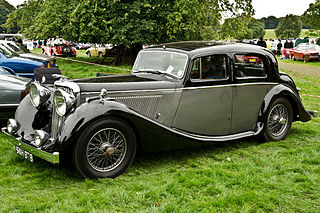
The Jaguar Mark IV is a range of automobiles built by Jaguar Cars from 1945 to 1949. The cars were marketed as the Jaguar 1½ litre, Jaguar 2½ litre and Jaguar 3½ litre with the Mark IV name later applied in retrospect to separate this model from the succeeding Mark V range.

The MG SA or MG 2-litre is a sporting saloon that was produced by MG from 1936 to 1939. Launched as the 2-litre, it only later became known as the SA, the car had been originally planned as an advanced performance saloon to rival the likes of SS Cars and even Bentley with all independent suspension and was given the factory code of EX150 and designated the S-type. A prototype was made but with the amalgamation of MG with Morris Motors in 1935, development stopped. The Cowley drawing office picked up the project again but a much more conservative car appeared with conventional live rear and beam front axles.

The MG VA, or MG 1½-litre as it was originally marketed, is a motor car that was produced by MG between February 1937 and September 1939 and was the smallest of the three sports saloons they produced in the late 1930s, the others being the SA and WA.

The Triumph Dolomite is a car that was produced by Triumph Motor Company from 1934 to 1940. It first appeared in 1934 as a sports car and the name was also used from 1937 on a series of sporting saloons and open cars until 1939 when the company went into receivership. A number were still sold and registered in 1940, though it is uncertain whether the receiver or new owner turned out cars from spare parts, or sold off completed cars. All except the Straight 8 featured a "waterfall" grille styled by Walter Belgrove, versions of the saloons with conventional grilles were sold as Continental models.

The Rolls-Royce 25/30 built between 1936 and 1938 is an updated version of the 20/25 with larger engine to provide more power, as over-large bodies had often been fitted to the earlier model leading to complaints about its performance.
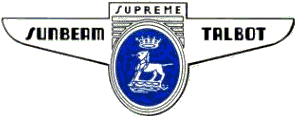
Sunbeam-Talbot Limited was a British motor manufacturing business. It built upmarket sports-saloon versions under the parenthood of Rootes Group cars from 1938 to 1954. Its predecessor Clément-Talbot Limited had made Talbot automobiles from 1902 to 1935.

The Triumph Gloria is a range of cars produced by the Triumph Motor Company in Coventry, England, from 1933 to 1938.

The Sunbeam-Talbot 90 is an automobile which was produced and built by Sunbeam-Talbot from 1948 to 1954 and continued as the Sunbeam Mk III from 1954 to 1957.

Salmson is a French engineering company. Initially a pump manufacturer, it turned to automobile and aeroplane manufacturing in the 20th century, returning to pump manufacturing in the 1960s, and re-expanded to a number of products and services in the late 20th and into the 21st century. It is headquartered in Chatou and has production facilities in Laval. It has subsidiaries in Argentina, Italy, Lebanon, Portugal, South Africa and Vietnam.

The Alvis TA 14, also called the Alvis Fourteen, was the first car that the car maker and defence contractor Alvis cars produced after World War II. The entire car factory had been destroyed on the night of Thursday 14 November 1940. Announced in November 1946, it was made until 1950, when its postwar austerity 1900 cc engine was replaced by the 2993 cc 26.25 HP Alvis Three Litre or TA 21.
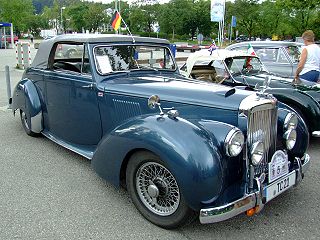
The Alvis Three Litre, TC 21 is an automobile produced by British manufacturer Alvis between 1953 and 1955. An updated version of the Three Litre TA 21, it was available as a 4-door saloon and, in its later TC 21/100 form, also as a 2-door drophead coupé.
The Rover 16/50 and Rover 16 are mid-sized cars which were produced by Rover from 1926 to 1929 and non-continuously from 1936 to 1947 respectively.

The Humber Snipe was a four-door luxury saloon introduced by British-based Humber Limited for 1930 as a successor to the Humber 20/55 hp at the same time as the similar but slightly longer Humber Pullman.

The Riley 12/6 was a car made by the British Riley company from late 1932 to 1935.
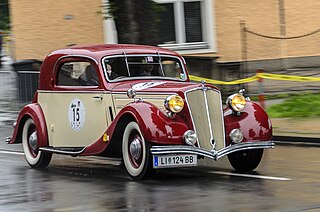
The Salmson S4 is a mid-size executive-level car introduced as the Salmson S4 C by Société des Moteurs Salmson in Autumn 1932. It was the manufacturer's principal and often sole model for the next twenty years.
The Singer Twelve name was used for several automobiles produced by Singer Motors. The "Twelve" in the name referred to the taxation horsepower rating in the United Kingdom.

















